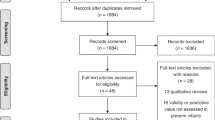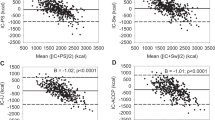Abstract
Background/Objective:
This study assessed the extent to which ulna length could be used to predict height and body mass index (BMI) in various groups of English and Portuguese hospitalised patients, and tidal volumes in critically ill patients at risk of requiring ventilatory support.
Subjects/Methods:
Bedside measurements of weight, height and ulna length were made in 507 patients (432 English, 75 Portuguese; 264 men, 243 women) with a mean age of 61.8±18.9 years, height 165.1±9.5 cm and BMI 26.7±5.43 kg/m2.
Results:
Ulna length could be measured with ease in all subjects. The intra-observer technical error of measurement in the same subjects was 1%. Within each category of men and women aged <65 years and 65 years and over, there was no significant difference between the English and Portuguese in the intercept or regression coefficients for the ulna–height relationships. A strong relationship was found between predicted and measured height (r=0.963, standard error of the estimate 4.6 cm). The overall mean and s.d. of the difference was 0.3±2.7% of height, with no significant difference between English and Portuguese populations. The discrepancy between measured and predicted BMI corresponded to 0.7±5.5% (s.d.) (all subjects) and for ventilatory volumes predicted from height (critically ill subjects only) 0.7±7.1%.
Conclusion:
Height can be predicted from ulna length with precision and ease in a wide range of patient groups, and without the need to use different equations in English and Portuguese populations. The predicted measurements are acceptable in most clinical circumstances.
This is a preview of subscription content, access via your institution
Access options
Subscribe to this journal
Receive 12 print issues and online access
$259.00 per year
only $21.58 per issue
Buy this article
- Purchase on Springer Link
- Instant access to full article PDF
Prices may be subject to local taxes which are calculated during checkout





Similar content being viewed by others
References
Agnihotri AK, Kachhwaha S, Jowaheer V, Singh AP (2009). Estimating stature from percutaneous length of tibia and ulna in Indo-Mauritian population. Forensic Sci Int 187, 109 e101–103.
Auyeung TW, Lee JS, Kwok T, Leung J, Leung PC, Woo J (2009). Estimation of stature by measuring fibula and ulna bone length in 2443 older adults. J Nutr Health Aging 13, 931–936.
Bland JM, Altman DG (1986). Statistical methods for assessing agreement between two methods of clinical measurement. Lancet 1, 307–310.
Bogin B, Kappell M, Varela Silva MI, Orden AB, Smith PK, Loucky J (2001). How genetic are human body proportions?. In: Dasgupta P, Hauspie R (eds). Human Growth Development and Maturation. Kluwer Academic Publisher: Dordrecht, pp 205–221.
Bogin B, Smith P, Orden AB, Varela Silva MI, Loucky J (2002). Rapid change in height and body proportions of Maya American children. Am J Hum Biol 14, 753–761.
Cheng HS, See LC, Shieh YH (2001). Estimating stature from knee height for adults in Taiwan. Chang Gung Med J 24, 547–556.
Cheng JC, Leung SS, Chiu BS, Tse PW, Lee CW, Chan AK et al. (1998). Can we predict body height from segmental bone length measurements? A study of 3647 children. J Pediatr Orthop 18, 387–393.
Chumlea WC, Roche AF, Steinbaugh ML (1985). Estimating stature from knee height for persons 60 to 90 years of age. J Am Geriatr Soc 33, 116–120.
Chunlea WC, Guo S (1992). Equations for predicting stature in white and black elderly individuals. J Gerontol 47, M197–M203.
Crapo RO, Crapo JD, Morris AH (1982a). Lung tissue and capillary blood volumes by rebreathing and morphometric techniques. Respir Physiol 49, 175–186.
Crapo RO, Morris AH, Clayton PD, Nixon CR (1982b). Lung volumes in healthy nonsmoking adults. Bull Eur Physiopathol Respir 18, 419–425.
Duarte AC, Catellani FB (2002). Semiologia Nutricional. Axcel Books: Rio de Janeiro.
Elia M, Betts P, Jackson DM, Mulligan J (2007). Fetal programming of body dimensions and percentage body fat measured in prepubertal children with a 4-component model of body composition, dual-energy X-ray absorptiometry, deuterium dilution, densitometry, and skinfold thicknesses. Am J Clin Nutr 86, 618–624.
Elia M, Russell CA (2009). Screening for Malnutrition in Sheltered Housing; BAPEN: Redditch, UK.
Elia M (Chairman and Editor) (2003). The ‘MUST’ report. Nutritional screening for adults: a multidisciplinary responsibility. Development and use of the ‘Malnutrition Universal Screening Tool’ (‘MUST’) for adults. A report by the Malnutrition Advisory Group of the British Association for Parenteral and Enteral Nutrition. p 127.
Felici A, Verweij J, Sparreboom A (2002). Dosing strategies for anticancer drugs: the good, the bad and body-surface area. Eur J Cancer 38, 1677–1684.
Gauld LM, Kappers J, Carlin JB, Robertson CF (2004). Height prediction from ulna length. Dev Med Child Neurol 46, 475–480.
Gray DS, Crider DS, Kelley C, Dickinson LC (1985a). Accuracy of recumbent height measurement. J Parenter Enteral Nutr 9, 712–715.
Gray DS, Crider JB, Kelley C, Dickinson LC (1985b). Accuracy of recumbent height measurement. JPEN J Parenter Enteral Nutr 9, 712–715.
Gunnell DJ, Davey Smith G, Frankel S, Nanchahal K, Braddon FE, Pemberton J et al. (1998). Childhood leg length and adult mortality: follow up of the Carnegie (Boyd Orr) Survey of Diet and Health in Pre-war Britain. J Epidemiol Community Health 52, 142–152.
Guzman Hernanndez C, Reinoza Calderon G, Hernandez Hernandez RA (2005). Estimation of height from leg length measured with tape measure. Nutr Hosp 20, 358–363.
Haboubi NY, Hudson PR, Pathy MS (1990). Measurement of height in the elderly. J Am Geriatr Soc 38, 1008–1010.
Hays W (1994). Statistics 5th edn. Harcout Brace College Publishers: London.
Jantz LM, Jantz RL (1999). Secular change in long bone length and proportion in the United States, 1800–1970. Am J Phys Anthropol 110, 57–67.
Jin R, Grunkemeier GL, Brown JR, Furnary AP (2008). Estimated glomerular filtration rate and renal function. Ann Thorac Surg 86, 1–3.
Joshi NB, Patel MP, Dongre AV (1964). Regression equation of height on ulnar length. Indian J Med Res 52, 1088–1091.
Knous BL, Arisawa M (2002). Estimation of height in elderly Japanese using region-specific knee height equations. Am J Hum Biol 14, 300–307.
Kwok T, Whitelaw MN (1991). The use of armspan in nutritional assessment of the elderly. J Am Geriatr Soc 39, 492–496.
Lack JA, Stuart-Taylor ME (1997). Calculation of drug dosage and body surface area of children. Br J Anaesth 78, 601–605.
Leary TS, Milner QJ, Niblett DJ (2000). The accuracy of the estimation of body weight and height in the intensive care unit. Eur J Anaesthesiol 17, 698–703.
McCammon RW (1970). Human Growth and Development. Charles C Thomas: Illinois.
Munoz JI, Linares-Iglesias M, Suarez-Penaranda JM, Mayo M, Miguens X, Rodriguez-Calvo MS et al. (2001). Stature estimation from radiographically determined long bone length in a Spanish population sample. J Forensic Sci 46, 363–366.
Myers SA, Takiguchi S, Yu M (1994). Stature estimated from knee height in elderly Japanese Americans. J Am Geriatr Soc 42, 157–160.
Palloni A, Guend A (2005). Stature prediction equations for elderly Hispanics in Latin American countries by sex and ethnic background. J Gerontol A Biol Sci Med Sci 60, 804–810.
Palmer CE (1932). The relationship of body length to supine body length. Hum Biol 4, 262–271.
Reilly T, Tyrrell A, Troup JD (1984). Circadian variation in human stature. Chronobiol Int 1, 121–126.
Roche AF, Davila GH (1974). Differences between recumbent length and stature within individuals. Growth 38, 313–320.
Smith SL (2007). Stature estimation of 3–10-year-old children from long bone lengths. J Forensic Sci 52, 538–546.
Stevenson RD (1995). Use of segmental measures to estimate stature in children with cerebral palsy. Arch Pediatr Adolesc Med 149, 658–662.
Tanner JM, Hayashi T, Preece MA, Cameron N (1982). Increase in length of leg relative to trunk in Japanese children and adults from 1957 to 1977: comparison with British and with Japanese Americans. Ann Hum Biol 9, 411–423.
The acute respiratory distress syndrome network (2000). Ventilation with lower tidal volumes as compared with traditional tidal volumes for acute lung injury and the acute respiratory distress syndrome. The Acute Respiratory Distress Syndrome Network. N Engl J Med 342, 1301–1308.
Valk IM (1971). Accurate measurement of the length of the ulna and its application in growth measurement. Growth 35, 297–310.
Watt T, Clayton J, Keegan MA, Campbell IT (1995). Measuring the height of critically ill patients in bed. Proc Nut Soc 54, 116A (abst).
Zhou XR, Shu YK, Chang YF, Deng ZH, Zhang ZH, Chen XG et al. (2007). Stature estimation from upper extremity long bones by digital radiography. Fa Yi Xue Za Zhi 23, 418–423, 427.
Acknowledgements
We wish to thank University staff and also staff working on the wards, who helped with this study in England and Portugal. Professor Philip Calder coordinated a previous study associated with fish oil supplementation in ICU in Portugal, which was linked to the present study.
Author information
Authors and Affiliations
Corresponding author
Ethics declarations
Competing interests
The authors declare no conflict of interest.
Additional information
Contributors: ME and RJS established the UK data. VMB coordinated the data collection in Portugal and was facilitated by EL. The authors commented on the paper that was drafted by ME.
Rights and permissions
About this article
Cite this article
Barbosa, V., Stratton, R., Lafuente, E. et al. Ulna length to predict height in English and Portuguese patient populations. Eur J Clin Nutr 66, 209–215 (2012). https://doi.org/10.1038/ejcn.2011.177
Received:
Revised:
Accepted:
Published:
Issue Date:
DOI: https://doi.org/10.1038/ejcn.2011.177
Keywords
This article is cited by
-
Relationship of carrying angle with grip strength and anthropometric measurements in young adults
Bulletin of Faculty of Physical Therapy (2023)
-
A cross-sectional survey to investigate the quality of care in Tuscan (Italy) nursing homes: the structural, process and outcome indicators of nutritional care
BMC Health Services Research (2015)
-
Hand length as an alternative measurement of height
European Journal of Clinical Nutrition (2014)



